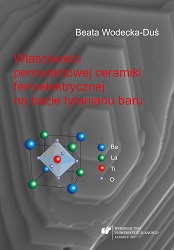Właściwości perowskitowej ceramiki ferroelektrycznej na bazie tytanianu baru
Properties of perovskite ferroelectric ceramics on the basis of barium titanate
Author(s): Beata Wodecka-Duś
Subject(s): Geography, Regional studies
Published by: Wydawnictwo Uniwersytetu Śląskiego
Keywords: ferroelectric ceramics; perovskite ceramics; barium titanate; lanthanum barium
titanate; sol-gel method; impedance spectroscopy; PTCR effect; piezoresistive effect; piezoelectric effect
Summary/Abstract: This book is a habilitation monography, devoted mostly to ferroelectric perovskite ceramics, on a warp of barium titanate, both undoped and doped with lanthanum and iron ions. It includes original results of BaTiO3 (BT), Ba1−xLaxTi1−x/4O3 (BLT) and Ba1−xLaxTi1−yFeyO3 (BLTF) ceramics properties analysis of the material obtained using conventional and sol-gel preparing methods. In particular the Author has focused on microstructure and crystalline structure of the material, as well as dielectric, electric, pyroelectric, thermo- and piezoresistive features of the obtained samples along with potential application possibilities.The conducted analysis has led to obtaining a new, semiconductive ceramics material —Ba0,996La0,004Ti0,999O3 (BLT4), with a colossal dielectric permittivity value. As its dielectric loss level is relatively low at the same time, the material can be considered as an alternative filler of ultracapacitors. Piezoresistive properties in a room temperature have also been observed for the investigated ceramics, so it can be assumed that the material could become a core of piezoresistive pressure sensors. Moreover, samples presented in the book exhibit posistor properties in the temperatures above Curie temperature, which makes them adequate for application in PTCR temperatures (Positive Temperature Coefficient of Resistivity). Doping barium titanate with iron ions leads to the significant improvement in piezoelectric properties, which translates into e.g. major increase of d33 piezoelectric coefficient. That puts the discussed ceramics material among lead-free materials which are tough competition for PZT‑type ceramics, used for obtaining lead-free piezoelectrics.An additional asset of the synthesized materials is an economic, and environment-friendlytechnology of obtaining. The discussed construction materials would be successfully applied in innovative electronic components, dedicated to applications in modern mechatronic and automatic systems.
Series: Kultura, Sztuka, Muzyka
- E-ISBN-13: 978-83-226-3248-2
- Print-ISBN-13: 978-83-226-3247-5
- Page Count: 186
- Publication Year: 2017
- Language: Polish
- eBook-PDF
- Table of Content
- Introduction

